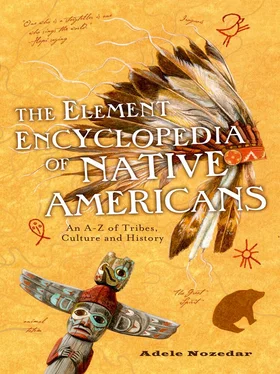1 ...8 9 10 12 13 14 ...30 In the Ojibwelanguage, the wiigwaasabak are scrolls made of the flexible, long-lasting bark of the paper birch tree, which peels from the tree neatly and cleanly. The Ojibwe used these sheets to inscribe pictures and designs depicting all sorts of information: songs, rituals, maps, the movement of the stars, and the history of a family, clan or tribe. Sometimes the scrolls were themselves used in rituals, in which case they incorporated the word midewiwin(medicine), and were therefore named midewiigwaas .
The designs were drawn or inscribed onto the soft inner side of the bark with a tool made out of bone or wood. The resulting indentations were made more visible by rubbing soft charcoal into them. If the scroll that was being made needed to be bigger than a single sheet of bark, then separate pieces of bark were stitched together using the strappy roots of pine trees. Once completed, the scroll was tightly rolled up and placed for safe keeping in a cylindrical box, also made of birch bark. These boxes might then be secreted away underground or in hiding places; after a few years had elapsed, the information might be copied onto another sheet of birch bark to ensure that the information remained intact. The scrolls could measure as little as a single sheet or as large as several yards of bark stitched together. We know that the scrolls have been in use for at least 400 years.
The discovery of certain scrolls have revealed important aspects of Ojibwe history: for example, the route of the migration of the tribe toward the west from the eastern part of North America. Thanks to these scrolls, we also know about the discovery of white cowrie shells, which are found only in certain saltwater areas.
The scrolls are very much a piece of living history, kept alive by the Native peoples of today, particularly among the medicine ( midewiwin ) societies. The contents of the scrolls are often memorized, and the interpretations can remain a secret among the elders of the group.
See Sacajawea
The Native Americans of the southeast blended a particular type of brew which they then used in ritual and ceremonial practice. The primary ingredient of the tea was a poisonous plant called Ilex vomitoria ; also included were tobaccoand other herbs. As the name of the main ingredient might suggest, the tea induced vomiting, believed to detoxify the body as well as provide visions.
“And I say the sacred hoop of my people was one of the many hoops that made one circle, wide as daylight and as starlight, and in the center grew one mighty flowering tree to shelter all the children of one mother and one father.”
1863–1950
That we know so much about the life of Black Elk is because of a man named John Neihardt. As an historian and ethnographer, Neihardt was, in the interests of his personal research, searching out Native Americans who had a perspective on the Ghost Dance Movement. He was introduced to Black Elk in 1930, and thus began a productive collaboration which would provide a major contribution to the Western perspective on Native American life and spirituality—coming, as it did, from an authority on such subjects. The books they produced, including Black Elk Speaks , became classics, and are still in print today.
Living during the time that he did, Black Elk was in a unique position: born into the Oglala Lakotadivision of the Sioux, he not only participated in the Battle of Little Big Hornin 1876, when he would have been 12 or 13, but also toured as part of Buffalo BillCody’s Wild West Show in the 1880s, and traveled to England when the show was performed for Queen Victoria in 1887. He was 27 when the massacre at Wounded Knee took place in 1890, during which he sustained an injury.
Black Elk was a heyoka, a medicine man, and a distant cousin to Crazy Horse. Elk was born in Wyoming in 1863. Acknowledged as a spiritual leader and as a visionary, Black Elk’s first revelation came to him when he was just nine years old, although he did not speak of it until he was older. In this vision, he said, he met the Great Spiritand was shown the symbol of a tree, which represented the Earth and the Native American people.
After Wounded Knee, Black Elk returned to the Pine Ridge Reservationand converted to Christianity. He married Katie War Bonnet in 1892. All three of their children, as well as their mother, embraced the Catholic faith, and in 1903, after Katie died, Black Elk, too, was baptized, although he remained the spiritual leader among his own people. He saw no inherent problems in worshipping both the Christian God and Wakan Tanka, or the Great Spirit—an open-minded attitude which undoubtedly was not shared by his fellow Catholic. Black Elk married once more in 1905, and he and Anna Brings White had three more children. He was one of the few surviving Sioux to have first-hand knowledge of the rituals and customs of the tribe, and he revealed some of these secrets to both Neihardt and Joseph Epes Brown, who published books based on his knowledge.
BLACK HAWK (MAKATAIMESHEKIAKIAK)
“ Courage is not afraid to weep, and she is not afraid to pray, even when she is not sure who she is praying to.”
1767–1838
In what is now called Rock Island, Illinois, there was once a village called Saukenuk, and this is where Black Hawk, also known as Black Sparrow Hawk, was born. His father, Pyesa, was the medicine manof the tribe, and, in accordance with his destiny to follow in his father’s footsteps, Black Hawk inherited Pyesa’s medicine bagafter Pyesa was killed in a battle with some Cherokee.
Like many other young men of his people, Black Hawk trained in the arts of battle from an early age. When he was 15, he took his first scalp after a raid on the Osagetribe. Four years later he would lead another raid on the Osage, and kill six people, including a woman. This was typical of the training in warfare given to young Native Americans.
After the death of his father Pyesa, Black Hawk mourned for a period of about six years, during which time he also trained himself to take on the mantle of his father, as medicine man of his people. It would also prove a part of his destiny to lead his people as their chief, too, although he didn’t actually belong to a clan that traditionally gave the Sauk their chiefs. It was Black Hawk’s instinctive skill at warcraft that accorded him the status of chief; this sort of leader by default was generally named a “war chief” since, sometimes, circumstances dictate the mettle of the leader that was needed.
When he was 45, Black Hawk fought in the 1812 war on the side of the British under the leadership of Tecumseh. This was an alliance that split the closely aligned Sauk and Foxtribes. The Fox leader, Keokuk, elected to side with the Americans. The war pitted the North American colonies situated in Canada against the U.S. Army. Britain’s Native American allies were an important part of the war effort, and a fur-trader-turned-colonel, Robert Dickson, had pulled together a decent sized army of Natives to assist in the efforts. He also asked Black Hawk, along with his 200 warriors, to be his ally. When Black Hawk agreed, he was given leadership of all the Natives, and also a silk flag, a medal, and a certificate. He was also “promoted” to the rank of Brigadier General.
Читать дальше












